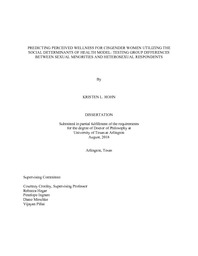
ATTENTION: The works hosted here are being migrated to a new repository that will consolidate resources, improve discoverability, and better show UTA's research impact on the global community. We will update authors as the migration progresses. Please see MavMatrix for more information.
Show simple item record
| dc.contributor.advisor | Cronley, Courtney | |
| dc.creator | Hohn, Kristen Leigh | |
| dc.date.accessioned | 2018-11-14T16:24:53Z | |
| dc.date.available | 2018-11-14T16:24:53Z | |
| dc.date.created | 2018-08 | |
| dc.date.issued | 2018-07-31 | |
| dc.date.submitted | August 2018 | |
| dc.identifier.uri | http://hdl.handle.net/10106/27598 | |
| dc.description.abstract | The purpose of this investigation was to bridge a gap in the literature about health disparities experienced across the intersection of multiple identities of women in the United States. Through the theoretical frameworks of the Structural Determinants of Health (SDH; Solar & Irwin, 2010) and Minority Stress Theory (Meyer, 2003), the researcher conducted a cross-sectional anonymous online survey to test the multifaceted SDH statistical model with the Perceived Wellness Survey (PWS) as an outcome indicator for perceived health for sexual minority and non-sexual minority women. A great collection of research reveals increased rates of mental health problems, rates of victimization, and some physical health disparities among the sexual minority population (Plöderl & Tremblay, 2015; Simoni, Smith, Oost, Lehavot, & Fredriksen-Goldsen, 2017). With an estimated population of over 5.5 million sexual minority women in the U.S. (Gates, 2017), it is critical to understand the full extent of health disparities by sexual minority women. The hypotheses of this study are: (1) The PWS will become more reliable for heterosexual, lesbian, and bisexual women once sexuality concerns are added to the survey; and (2) The Intermediary Determinants of Health (a component within the SDH) will mediate the PWS between heterosexual, lesbian, and bisexual women. The researcher developed the statistical model to test the integration of the SDH and MST frameworks by creating composite scores for each of the health-predicting factors. The model supported the SDH framework for all white women grouped, with white millennial women fitting the SDH model most accurately. The models for minority women, regardless of age cohort or sexual orientation, did not meet all criteria for partial mediating mediation. The theoretical, research and practice implications are discussed. | |
| dc.format.mimetype | application/pdf | |
| dc.language.iso | en_US | |
| dc.subject | Social determinants of health | |
| dc.subject | Sexual minority | |
| dc.subject | Women's health | |
| dc.subject | Health disparities | |
| dc.title | Predicting Perceived Wellness for Cisgender Women Utilizing the Social Determinants of Health Model: Testing Group Differences Between Sexual Minorities and Heterosexual Respondents | |
| dc.type | Thesis | |
| dc.degree.department | Social Work | |
| dc.degree.name | Doctor of Philosophy in Social Work | |
| dc.date.updated | 2018-11-14T16:24:53Z | |
| thesis.degree.department | Social Work | |
| thesis.degree.grantor | The University of Texas at Arlington | |
| thesis.degree.level | Doctoral | |
| thesis.degree.name | Doctor of Philosophy in Social Work | |
| dc.type.material | text | |
| dc.creator.orcid | 0000-0002-7555-0811 | |
Files in this item
- Name:
- HOHN-DISSERTATION-2018.pdf
- Size:
- 4.177Mb
- Format:
- PDF
This item appears in the following Collection(s)
Show simple item record


